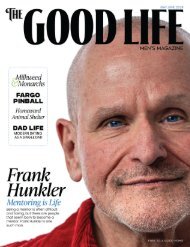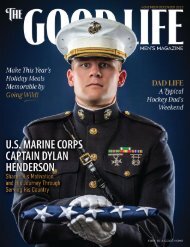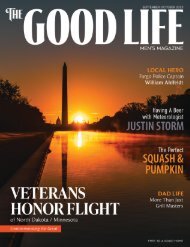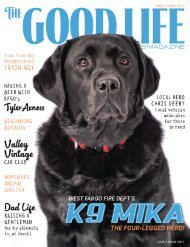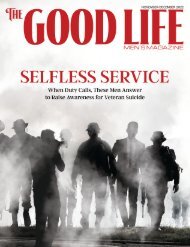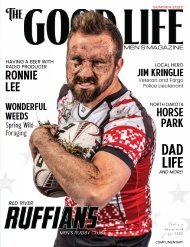The Good Life – March-April 2015
Fargo Moorhead's Only Men's Magazine - Featuring Chris Berg, Local Heroes - American Red Cross, Having a Beer with Lt. Joel Vettel, Car Clubs and More!
Fargo Moorhead's Only Men's Magazine - Featuring Chris Berg, Local Heroes - American Red Cross, Having a Beer with Lt. Joel Vettel, Car Clubs and More!
Create successful ePaper yourself
Turn your PDF publications into a flip-book with our unique Google optimized e-Paper software.
volunteer membership grew from 17,000 to over 20<br />
million. During that time the Red Cross trained, staffed<br />
hospitals and ambulance companies, and registered a<br />
small army of nurses to serve the military as well as<br />
combat the worldwide influenza epidemic of 1918.<br />
During all of the wars the United States has been<br />
involved in to this day, <strong>The</strong> Red Cross has played an<br />
integral part in aiding our soldiers and their families,<br />
our Allies and countless civilian war victims. After<br />
World War II, it was the Red Cross who began the first<br />
nationwide civilian blood program. Today it supplies<br />
at least 40 percent of the blood and blood products<br />
used in the United States.<br />
THE RED CROSS TODAY AND WHAT HAS CHANGED<br />
One of the primary changes has been funding.<br />
<strong>The</strong> government no longer subsidizes each and every<br />
chapter in each and every city and town. Secondly,<br />
the Red Cross responds to disasters, be they natural<br />
or man-made regardless wherever they occur the same<br />
everywhere. <strong>The</strong> reason for this is because, about a<br />
year ago, <strong>The</strong> American Red Cross realized in order<br />
to remain effective they needed to change how they<br />
manage what they do.<br />
Today each section of the country is broken<br />
down into “regions” that the Red Cross is primarily<br />
32<br />
responsible for. <strong>The</strong>re are seven National Divisions<br />
of the Red Cross. Within the seven divisions there are<br />
sixty-four Regions.<br />
<strong>The</strong> Dakotas Region is large, as it encompasses<br />
all of South Dakota, North Dakota and ten counties<br />
in Northwestern Minnesota. Population wise, that is<br />
approximately 900,000 people. What is so amazing<br />
about that is that the Red Cross has an employed staff<br />
of only 17 — that’s SEVENTEEN people. Everyone else<br />
who serves and helps during any and all times of need<br />
is a volunteer. Brian Shawn, Sean Coffman and Terry<br />
Askin are three of the key people who communicate,<br />
coordinate and handle whatever needs to be done<br />
when a disaster is called in.<br />
“Without the amazing people we have who are<br />
willing to help and volunteer time after time, we<br />
couldn’t do what needs to be done” Brian Shawn says<br />
often during our conversation. Locally there are 150<br />
volunteers. On a regional level estimates range to<br />
about 850 volunteers. Terry Askin, who often works<br />
on the line with the volunteers, says “they are usually<br />
a very diverse group. Many are moms and dads with<br />
grown kids and retired people who like to pitch in and<br />
help.”<br />
<strong>The</strong> Red Cross today does more than respond to<br />
disasters—they do whatever they can to prevent them




